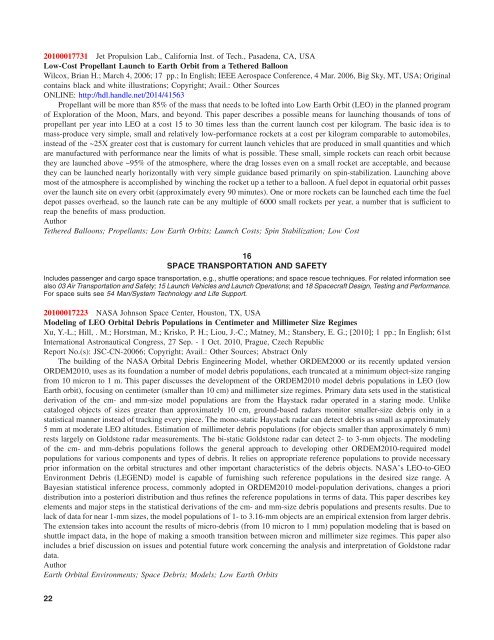NASA Scientific and Technical Aerospace Reports - The University ...
NASA Scientific and Technical Aerospace Reports - The University ...
NASA Scientific and Technical Aerospace Reports - The University ...
Create successful ePaper yourself
Turn your PDF publications into a flip-book with our unique Google optimized e-Paper software.
20100017731 Jet Propulsion Lab., California Inst. of Tech., Pasadena, CA, USA<br />
Low-Cost Propellant Launch to Earth Orbit from a Tethered Balloon<br />
Wilcox, Brian H.; March 4, 2006; 17 pp.; In English; IEEE <strong>Aerospace</strong> Conference, 4 Mar. 2006, Big Sky, MT, USA; Original<br />
contains black <strong>and</strong> white illustrations; Copyright; Avail.: Other Sources<br />
ONLINE: http://hdl.h<strong>and</strong>le.net/2014/41563<br />
Propellant will be more than 85% of the mass that needs to be lofted into Low Earth Orbit (LEO) in the planned program<br />
of Exploration of the Moon, Mars, <strong>and</strong> beyond. This paper describes a possible means for launching thous<strong>and</strong>s of tons of<br />
propellant per year into LEO at a cost 15 to 30 times less than the current launch cost per kilogram. <strong>The</strong> basic idea is to<br />
mass-produce very simple, small <strong>and</strong> relatively low-performance rockets at a cost per kilogram comparable to automobiles,<br />
instead of the ~25X greater cost that is customary for current launch vehicles that are produced in small quantities <strong>and</strong> which<br />
are manufactured with performance near the limits of what is possible. <strong>The</strong>se small, simple rockets can reach orbit because<br />
they are launched above ~95% of the atmosphere, where the drag losses even on a small rocket are acceptable, <strong>and</strong> because<br />
they can be launched nearly horizontally with very simple guidance based primarily on spin-stabilization. Launching above<br />
most of the atmosphere is accomplished by winching the rocket up a tether to a balloon. A fuel depot in equatorial orbit passes<br />
over the launch site on every orbit (approximately every 90 minutes). One or more rockets can be launched each time the fuel<br />
depot passes overhead, so the launch rate can be any multiple of 6000 small rockets per year, a number that is sufficient to<br />
reap the benefits of mass production.<br />
Author<br />
Tethered Balloons; Propellants; Low Earth Orbits; Launch Costs; Spin Stabilization; Low Cost<br />
16<br />
SPACE TRANSPORTATION AND SAFETY<br />
Includes passenger <strong>and</strong> cargo space transportation, e.g., shuttle operations; <strong>and</strong> space rescue techniques. For related information see<br />
also 03 Air Transportation <strong>and</strong> Safety; 15 Launch Vehicles <strong>and</strong> Launch Operations; <strong>and</strong> 18 Spacecraft Design, Testing <strong>and</strong> Performance.<br />
For space suits see 54 Man/System Technology <strong>and</strong> Life Support.<br />
20100017223 <strong>NASA</strong> Johnson Space Center, Houston, TX, USA<br />
Modeling of LEO Orbital Debris Populations in Centimeter <strong>and</strong> Millimeter Size Regimes<br />
Xu, Y.-L.; Hill, . M.; Horstman, M.; Krisko, P. H.; Liou, J.-C.; Matney, M.; Stansbery, E. G.; [2010]; 1 pp.; In English; 61st<br />
International Astronautical Congress, 27 Sep. - 1 Oct. 2010, Prague, Czech Republic<br />
Report No.(s): JSC-CN-20066; Copyright; Avail.: Other Sources; Abstract Only<br />
<strong>The</strong> building of the <strong>NASA</strong> Orbital Debris Engineering Model, whether ORDEM2000 or its recently updated version<br />
ORDEM2010, uses as its foundation a number of model debris populations, each truncated at a minimum object-size ranging<br />
from 10 micron to 1 m. This paper discusses the development of the ORDEM2010 model debris populations in LEO (low<br />
Earth orbit), focusing on centimeter (smaller than 10 cm) <strong>and</strong> millimeter size regimes. Primary data sets used in the statistical<br />
derivation of the cm- <strong>and</strong> mm-size model populations are from the Haystack radar operated in a staring mode. Unlike<br />
cataloged objects of sizes greater than approximately 10 cm, ground-based radars monitor smaller-size debris only in a<br />
statistical manner instead of tracking every piece. <strong>The</strong> mono-static Haystack radar can detect debris as small as approximately<br />
5 mm at moderate LEO altitudes. Estimation of millimeter debris populations (for objects smaller than approximately 6 mm)<br />
rests largely on Goldstone radar measurements. <strong>The</strong> bi-static Goldstone radar can detect 2- to 3-mm objects. <strong>The</strong> modeling<br />
of the cm- <strong>and</strong> mm-debris populations follows the general approach to developing other ORDEM2010-required model<br />
populations for various components <strong>and</strong> types of debris. It relies on appropriate reference populations to provide necessary<br />
prior information on the orbital structures <strong>and</strong> other important characteristics of the debris objects. <strong>NASA</strong>’s LEO-to-GEO<br />
Environment Debris (LEGEND) model is capable of furnishing such reference populations in the desired size range. A<br />
Bayesian statistical inference process, commonly adopted in ORDEM2010 model-population derivations, changes a priori<br />
distribution into a posteriori distribution <strong>and</strong> thus refines the reference populations in terms of data. This paper describes key<br />
elements <strong>and</strong> major steps in the statistical derivations of the cm- <strong>and</strong> mm-size debris populations <strong>and</strong> presents results. Due to<br />
lack of data for near 1-mm sizes, the model populations of 1- to 3.16-mm objects are an empirical extension from larger debris.<br />
<strong>The</strong> extension takes into account the results of micro-debris (from 10 micron to 1 mm) population modeling that is based on<br />
shuttle impact data, in the hope of making a smooth transition between micron <strong>and</strong> millimeter size regimes. This paper also<br />
includes a brief discussion on issues <strong>and</strong> potential future work concerning the analysis <strong>and</strong> interpretation of Goldstone radar<br />
data.<br />
Author<br />
Earth Orbital Environments; Space Debris; Models; Low Earth Orbits<br />
22

















